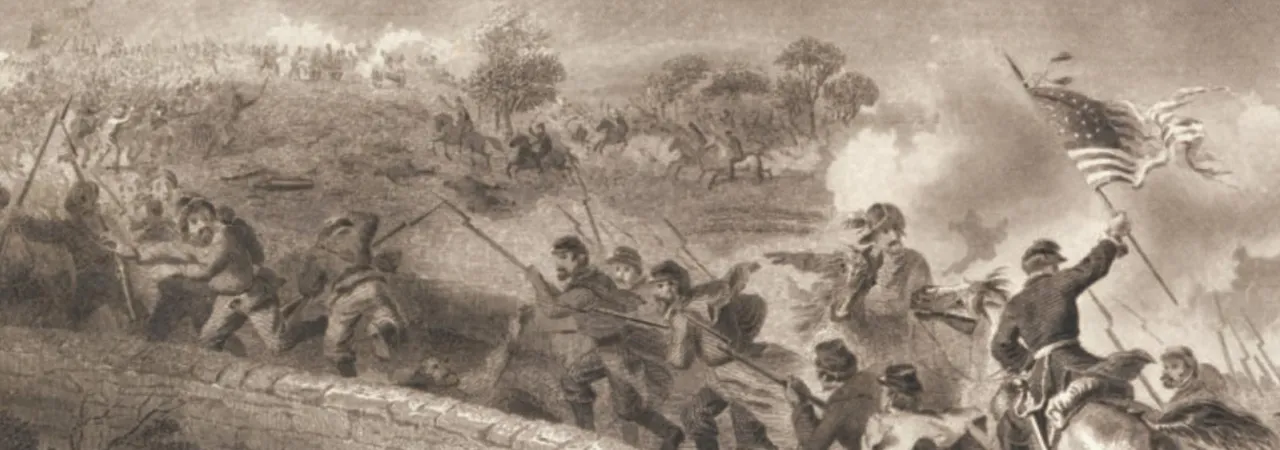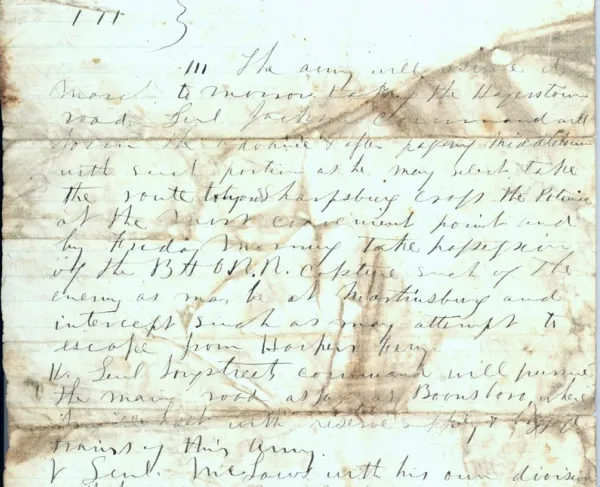
Everything combines to prove that the revolt is culminating in its strength. Upon the next few weeks hang interests of appalling magnitude.
Baltimore American and Commercial Advertiser, September 4, 1862
It’s September 11. The United States is under attack. Foreboding news bombards the president. Danger stabs Washington. The army stands at full alert. The navy patrols the Potomac. Abraham Lincoln is under siege in September 1862.
The Civil War had been raging for 17 months. The summer had been bloody — bloodier than any summer in American history. United States forces had attempted to capture the enemy’s capital at Richmond, Va., but they had failed. In seven stunning days, bullets and shells fired by Lee’s Southern gunners had killed and wounded nearly 16,000 U.S. soldiers. Cries of “On to Richmond!” — spurred by impatient politicians and an imprudent press — had turned into tears and fears for innocent widows, siblings and orphans.
Except for the grieving families and growing graveyards in the North, the war seemed far away. The battlefields belonged to the South. The target cities were Richmond and New Orleans and Charleston and Savannah. The states being conquered were Virginia and Tennessee and Mississippi and North Carolina. The conclusion was certain: the rebellious Confederate States of America would submit. The industrial machines and population power of the United States guaranteed victory. No other outcome seemed possible.
Then, astonishingly, the compass shifted north. Instead of Richmond, Washington became the centerpiece of contention. Lee raced his army toward the United States capital. He crushed a Union army blocking his path at Manassas, only 30 miles from the White House. Then he diverted. Instead of assaulting fortified Washington directly, Lee splashed across the Potomac River into Maryland. A Confederate tsunami surged onto the unstained soil of the North. Invasion!
“Their destination is Harrisburg or Philadelphia,” Pennsylvania governor. Andrew Curtin wrote in a distressed message to President Lincoln on September 11. “Send here not less than 80,000 disciplined forces.” The governor then issued Mr. Lincoln a challenge: “The time for decided action by the National Government has arrived. What may we expect?”
The Philadelphia Inquirer railed “one of the latent reasons why we have allowed this Rebellion to linger so long. We have not thought ourselves to be in danger.” Much had changed, indeed, since the final days of August, when “we saw only the skirts of the war cloud as it spread darkly over the distant sky. We would not believe that it was sailing slowly to our own zenith.”
Before day’s end on September 11, proposed Confederate peace terms suddenly appeared in Northern newspapers.
Rebel Roulette
The Confederacy had coveted Maryland since the outbreak of secession. From the outset, the secessionists had hoped the Mason-Dixon Line would be the northern border of the new nation, not the Potomac. Maryland was a slave state, sharing the sisterhood of the South’s culture and economy. Baltimore was the South’s largest city, and the fourth largest metropolis in the country. Maryland’s position astride the Chesapeake Bay, along with its array of railroads, made it crucial to Southern trade and commerce. And the state surrounded much of Washington, D.C.
When war erupted in the spring of 1861, and rioters in Baltimore killed Massachusetts volunteers en route to the capital, Lincoln seized the state. Baltimore was the first Southern city occupied by the Federal army. Annapolis was the first Southern capital patrolled by U.S. troops. Maryland was the first state in which martial law was imposed. Maryland’s legislators were placed under house arrest to guarantee no votes for secession. Bayonets ensured Maryland stayed in the Union.
Yet, in September 1862, the “liberation” of Maryland had never looked so favorable. The Richmond Whig predicted: “If their experience of despotism has produced its proper effect . . . and kindled the fire of resistance, instead of emasculating their spirit, they will hasten to seize the prize within their grasp. The pride, the self respect, and the sympathies of Maryland link her with the cause of the South.”
Benefits of an incursion into Maryland reached beyond the cause: Lee needed men and his army required supplies. Confederate soldiers began splashing across the Potomac at White’s Ford and Point of Rocks on September 4, planting the Rebel flag upon Maryland’s soil. Confederates cherished the moment. “Every regiment singing and as happy as if going to a ball,” recalled Virginia Capt. Samuel Buck, who witnessed hundreds of men wading the shallow ford, brass bands playing and joyous men singing, “Maryland, My Maryland.”
“The war has assumed a new phase,” declared the Richmond Enquirer. “The tables have been turned, and the Confederate army is now an army of invasion.”
Some in the South viewed the Confederate offensive as an opportunity for vengeance. They abhorred the U.S. armies for endless occupations that destroyed their crops and farms and plantations, making war upon civilians. They bristled at the sanctioned theft of private property, including escaped slaves, by Union forces. They were angry that their homeland had been invaded. They sought retribution.
The Richmond Dispatch called for action. “Let our commanders push promptly into the enemy’s country; let cavalry expeditions make raids into their territory, and seize and bring off their prominent citizens, to be held as hostages for the security of those of our own people who now languish in Federal prisons. Now, now is the time for the Congress and for the Army to strike a decisive blow for our salvation.”
Robert E. Lee expected to engage — and hoped to defeat — the U.S. Army in combat on Union soil. He did not, however, intend to commit war on civilians — certainly not in Maryland. “Any excesses committed will exasperate the people, lead to disastrous results, and enlist the populace on the side of the Federal forces in hostility to our own,” Lee informed his army on the eve of the invasion. He viewed his army as one of liberation, not oppression, coming to remove the Union bayonets that enforced martial law. He reasoned that his well-behaved and respectful army would encourage Marylanders to cast their allegiance with the Confederacy.
President Jefferson Davis prepared a proclamation to the people of Maryland, declaring that the South had “no design of conquest, or any other purpose than to secure peace and the abandonment by the United States of their pretensions to govern a people who have never been their subjects, and who prefer self-government to a union with them.” After justifying the invasion, the Confederate president then made an intriguing offer: “If [the people are] unable to prevail on the Government of the United States to conclude a general peace, their own State government, in the exercise of its sovereignty, can secure immunity from the desolating effects of warfare on the soil of the State by a separate treaty of peace.”
The test had come. Would the Northern states retain their bonds to the Union? Or would pleas for peace, compelled by invading Confederate armies, further divide the “united” states? The future of the United States appeared, at this moment, in the hands of Robert E. Lee.
Invader Intrigue
Mystery over Lee’s target intensified when he didn’t move from Frederick for four days. What was he thinking? What was he waiting for?
Hopeful Northern newspapers began postulating that the Confederates intended no invasion, but merely a temporary “raid.” “The general impression is that the invasion of Maryland is for food and other supplies, and not for a general raid into the State of Pennsylvania,” theorized the press. The belief was that Lee intended to return to Virginia with bountiful provender and clothing and shoes, but at the same time lure the Union army out of its Washington defenses to a place of Lee’s choosing.
The theorists were wrong. Lee expected to spend weeks on Yankee soil, but he faced an unexpected problem: Harpers Ferry.
Located 20 miles southwest of Frederick, Harpers Ferry was home to nearly 14,000 U.S. soldiers garrisoned at the mouth of the Shenandoah Valley — the umbilical cord between Lee’s invasion force and his supply base in Virginia. Their presence presented a serious threat to Lee’s plans to carry the war into Pennsylvania.
Lee had expected the Yankees would withdraw from the Shenandoah Valley once he occupied Frederick, since the garrison was effectively isolated and cut off from communication and support from either Washington or Baltimore. So, Lee waited. Tuesday, September 9 arrived — four days at Frederick, and still the Federals had not budged. Lee determined that since the Federals would not remove themselves, he would remove them.
Stonewall Jackson, commanding two-thirds of the Confederate army would descend upon Harpers Ferry and seize the three mountains surrounding it, trapping the doomed Federals in a natural hole, where they would have the options of surrender or destruction. Jackson would have three days to snap the trap upon the Ferry. Once Jackson had eliminated the U.S. garrison, his expedition would reunite with Lee in Maryland. With the supply line thus secured in the Shenandoah Valley, the way was open to Pennsylvania. Lee gave little concern to any danger from Yankee reinforcements. Jackson would complete his assignment well before the Federals passed too far from their Washington defenses.
Lee labeled his instructions “Special Orders 191.”
Slavery's Shackles
Not since the commencement of the war did the future of the Union appear more doubtful. So, when a contingent of ecumenical Christian ministers from Chicago arrived in Washington on September 11, it did not seem the opportune time to discuss the eradication of slavery from Southern soil. Yet they were determined to present an “emancipation memorial” to the president and waited two days for a meeting with Lincoln.
The ministers acknowledged their timing was inauspicious “in view of recent disasters which make the authority of the Government in the Slave States less extensive and influential than before.” The frank discussion lasted for more than one hour. “What good would a proclamation of emancipation from me do, especially as we are now situated?” the pragmatic Lincoln asked. “I do not want to issue a document that the whole world will see must necessarily be inoperative. . . . Would my word free the slaves, when I cannot even enforce the Constitution in the Rebel States?”
Despite acknowledging many of their points, Lincoln refused to yield to the ministers’ immediate demand for emancipation. “Understand, I raise no objection against it on legal or constitutional grounds; for, as commander in chief of the army and navy, in time of war I suppose I have a right to take any measure which may best subdue the enemy.” Timing, not philosophy, was the president’s issue. First he must vanquish the Confederate invaders.
During the presidential election, Southern hyperbole branded Lincoln an abolitionist. While he railed against the extension of slavery into new states or U.S. territories, he vowed not to interfere with slavery where it existed. But months of bloody, inconclusive civil war had modified Lincoln’s views. To win the war, he determined emancipation had become a military necessity. Eighteen months of civil war had modified — and even moderated — public views on slave emancipation. As he met with the ministers on September 13, the president never disclosed he already had prepared a draft emancipation proclamation.
“It is my earnest desire to know the will of Providence in this matter. And if I can learn what it is I will do it!” the president reminded the ministers. “These are not, however, the days of miracles, and I suppose it will be granted that I am not to expect direct revelation.”
A miracle, perhaps, was closer than anticipated.
Many Fronts
Lee’s halt at Frederick had Maj. Gen. George McClellan and the Lincoln government theorizing for a week. It convinced some that he was trying to lure McClellan out of the Washington fortifications, then choose a fight along the north-south line of the Monocacy River. Intelligence coming to Gov. Curtin in Harrisburg seemed to confirm this notion. He informed McClellan, “From all we can learn, the enemy has selected his ground and massed his force near Frederick, to give you battle, the result of which will probably decide the future of our country.”
The military intelligence was wrong. Even as Lee moved to Hagerstown, just over six miles from the Pennsylvania border, uncertainty plagued Washington. The Union high command had received troubling reports about Virginia. Tens of thousands of additional Confederates, according to intelligence sources, were on their way to join Lee, but had not yet crossed the Potomac. A frustrated Navy secretary Gideon Welles wrote, “The War Department is bewildered, knows but little, does nothing, proposes nothing.”
Despite uncertainties about Lee’s intentions, McClellan understood his assignments: protect Washington and Baltimore. But this depended upon rebuilding and reorganizing the two armies shattered by the summer battles around Richmond and Manassas.
The Baltimore American and Commercial Advertiser reserved no patience, believing only one solution to the Rebel invasion existed: “Force everything that is available into the field; every man, every gun, sword, revolver, and pound of powder, and end the war. We can do it, and do it soon. The nation is smarting under its needless reverses; it is worn out with delays. We have gone along leisurely.... We may talk of patriotism, of devotion, of singleness of purpose, but the Rebels themselves shame us.”
A posture of defense was an action for George McClellan. He contrived a three-wing strategy to defend against the Confederate menace in Maryland. His left wing would hug the Potomac, securing river crossings and ensuring no surprise Rebel approach from imagined enemy forces still in Virginia. The center wing would defend all roads leading from Frederick toward Washington. The right wing would start north to protect Baltimore.
Maintaining the railroad artery from Baltimore into Washington was critical — the line could convey 28,000 men in one convoy, along with 50–60 pieces of artillery, repeating the operation every 18–24 hours. McClellan chose Maj. Gen. Ambrose Burnside to command this critical wing. Burnside began marching nearly 24,000 men from Washington on September 8, establishing his headquarters at Brookeville, some 20 miles from the capital, the next day and placing him in position to block any raids toward Baltimore.
Late on September 9, McClellan received word from his cavalry that Stonewall Jackson and J.E.B. Stuart had located their headquarters well east of Frederick, indicating an intention to move on Baltimore. It turned out to be a false alarm. Unbeknownst to McClellan, Lee was headed in the opposite direction. As Burnside deployed to defend Baltimore, the Confederates began executing Special Orders 191, marching west toward Harpers Ferry and northwest to Hagerstown. Unaware of the Confederate deployment, McClellan was pleased. Washington was safe and Baltimore secure, allowing him to focus his army toward the enemy at Frederick.
The army had not marched great distances, but it had moved in sizzling heat. A soldier described his brigade on the march: “The hour of departure was six o’clock a.m. On we marched, knapsacks slung, and our spirits of the most joyous character. But as we advanced, the sun became more oppressive, the dust more blinding, our loads heavier, and strength and hilarity soon gave way to exhaustion and feebleness.”
Hundreds dropped from their ranks. Straggling became so epidemic that it forced McClellan to issue a specific order to correct the evil. Marauding and theft had become an embarrassment — when the Confederates passed through the region and had not stolen a chicken or burned a fence rail. The U.S. Army arrived, and Maryland citizens were subjected “to the pillage and plunder of our soldiers.”
The editor of the Baltimore American and Commercial Advertiser expressed disgust. “At this critical time, when the loyalty of Maryland hangs, as I believe, upon a very slender thread, this thieving is to me a cause of the most serious apprehension.” The observer marveled at the good behavior and discipline of the Rebels and the misbehavior and ill-discipline of the Federals. “It is humiliating to record the superior sagacity and discrimination with which the Rebels have managed the sentiment of the people wherever they have been.”
Fortune Found
On September 11, George McClellan proclaimed some good news: no more Confederates were expected from Virginia. Then he shared the bad news. “All the evidence that has been accumulated from various sources since we left Washington goes to prove most conclusively that almost the entire Rebel army in Virginia, amounting to not less than 120,000 men, is in the vicinity of Frederick City.”
As McClellan approached Frederick, he believed he was outnumbered. “They are probably aware that their forces are numerically superior to ours by at least 25 percent. . . . The momentous consequences involved in the struggle of the next few days impel me, at the risk of being considered slow and overcautious, to most earnestly recommend that every available man be at once added to this army.”
Lincoln responded, “I am for sending you all that can be spared,” and one corps was dispatched from Washington, rather than the three McClellan desired.
Meanwhile, at 8 p.m. on September 11, McClellan received news from Governor Curtin in Pennsylvania. “We have advices that the enemy broke up whole encampment at Frederick yesterday morning, 3 o’clock, and marched in direction of Hagerstown.”
McClellan already suspected the Confederates’ departure. His signal observatory atop Sugar Loaf Mountain could detect no large encampments or enemy movements about Frederick. He informed Halleck, “I have ordered [Burnside] to advance tomorrow, if possible, to Frederick and occupy it. . . . I shall follow up the Rebels as rapidly as possible.”
Burnside moved west toward Frederick along the National Road on Friday, September 12. He approached cautiously, encountering Confederate rearguard resistance when he arrived at the Monocacy River. But the Rebels were too few, and the bridge fell quickly to the Yankees. At about 4:00 p.m., the Federals hoisted the Stars and Stripes once again over the city. Early on Saturday morning, Burnside came into Frederick, heralded as a liberator. When McClellan entered town about 11:00 a.m. the people were “almost wild with joy.”
Robert E. Lee had Pennsylvania in sight as he waited at Hagerstown on Saturday morning, September 13. Artillery thundered from the distant mountains south of Hagerstown. Something was happening at Harpers Ferry, and Lee expected it to herald success from Jackson, who was about 24 miles distant — a day’s march for the celebrated “Foot Cavalry.”
All was now ready for the expedition across the Mason-Dixon Line. The Potomac River was so low that the ford at Williamsport presented an ideal crossing, and Lee expected wagon trains of provisions soon to be rumbling north to Hagerstown and beyond. Lee needed their arrival; food remained a problem for the hungry Confederates. Livestock had been rustled north into Pennsylvania or into the mountains to the west by Unionists, and Lee’s strict prohibitions against plundering made it difficult to obtain meat. “The supply of beef has been very small, and we have been able to procure no bacon.”
The discomfort of Confederate soldiers was mollified by a rousing reception in Hagerstown. The scribe for the Savannah Republican especially enjoyed the food. “Women fed the soldiers as they marched along, from baskets filled with provisions prepared for their advent; the little boys shouted hurrahs for Davis, and the men plainly told by their firm looks that their day had come and the Unionists had better stand clear.”
Though Lee had no intention of long-term occupation, his invasion faced bright prospects. But, like McClellan, he was beset by straggling. Lee knew the reasons that a third to a half of his troops had dropped from the ranks: forced marches, hard duty, little good food, bare feet. Many just quit.
Then there was the issue of the U.S. Army, following his rear.
Lee had expected Jackson’s mission to Harpers Ferry to be concluded by now. Delay was not good. If, indeed, the Federals had occupied Frederick, as Lee suspected, they were nearer to Maj. Gen. Lafayette McLaws — occupying Maryland Heights in support of the operation (19 miles) — than Jackson was to Lee (24 miles). Moreover, a good road from Frederick to Harpers Ferry led through the Potomac’s river gaps, making McLaws vulnerable to attack. Lee did not expect such a Federal initiative, but if the Unionists learned that their garrison was endangered, they may stage a rescue attempt.
George McClellan was worried about Harpers Ferry. The telegraph had been cut and no word had come from that quarter. On September 12, he had ordered cavalry to the Ferry to open communication and was making preparations to relieve the Union command stationed there.
As McClellan experienced his riotous reception in Frederick, even more joy awaited him. At some point on September 13, he was delivered an order. But it wasn’t to him; nor was it from him. The Union commander had come into possession of Lee’s Special Orders 191.
“I have all the plans of the Rebels, and will catch them in their own trap,” a confident and exuberant McClellan informed President Lincoln. “Will send you trophies.”
Related Battles
2,325
2,685
12,636
286
12,401
10,316
361
261






